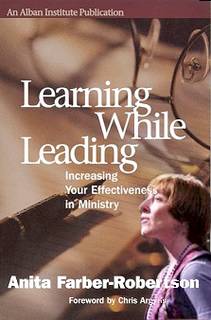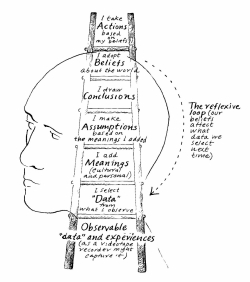How do we test our assumptions and convictions? When we come to critique our experience, our perception of our context, and our understanding of our tradition, what processes do we use to open up authentic dialogue?
Chris Argyris and Donald Schon have developed a learning discipline with several names: Action Science, action inquiry, action research, or organizational learning. A lot of their material can be found in their book, Theory in Practice. Peter Senge has run with the idea in his book, The Fifth Discipline, implementing the practice of learning organization in business circles.
 Anita Farber Robertson, a Unitarian minister in Rockford, Massachussets, has written a book, Learning While Leading, Alban Institute, 2000, for churches wanting to apply action science to theological reflection. She says that the action science approach helps Christian communities identify gaps and inconsistencies in the theories that inform their practice. Instead of continuing to make the same mistakes again and again, local leaders can use action science disciplines to have a look at what really is going on.
Anita Farber Robertson, a Unitarian minister in Rockford, Massachussets, has written a book, Learning While Leading, Alban Institute, 2000, for churches wanting to apply action science to theological reflection. She says that the action science approach helps Christian communities identify gaps and inconsistencies in the theories that inform their practice. Instead of continuing to make the same mistakes again and again, local leaders can use action science disciplines to have a look at what really is going on.
Argyris talks about designed blindness – in which we collude with our culture to overlook certain realities. We are so bound up with cognitive dissonance, often because we believe it is shameful to be imperfect and growing. He says that because our mental models provide a framework for our action as individuals and communities, we should pay attention to how those mental models are formed.
 When looking at the formation of our mental models Argyris suggests we should consciously use the “ladder of inference”. Start at the bottom of the ladder with directly observable data. Then notice which data you’re paying attention to. What cultural and personal meanings are we giving to what we observe? What assumptions are we making based on those meanings? What conclusions are we drawing? What beliefs about the world are we now forming? Now – what are the actions that result?
When looking at the formation of our mental models Argyris suggests we should consciously use the “ladder of inference”. Start at the bottom of the ladder with directly observable data. Then notice which data you’re paying attention to. What cultural and personal meanings are we giving to what we observe? What assumptions are we making based on those meanings? What conclusions are we drawing? What beliefs about the world are we now forming? Now – what are the actions that result?
Using this ladder we can identify ‘leaps of abstraction’ in which we miss steps out and overlook important parts of the process. We can go back and re-explore phases that have been missed. We can identify points of dissonance. This links in with Whiteheads’ first step of attending. With one group, I used an actual step ladder to help people enact this in relation to a case study.
Another important contribution of action science is the concept of advocacy and inquiry being valued equally. “I can tell you what I believe and why (advocacy) while paying attention to what you believe and why (inquiry)”. This ties in strongly with Whiteheads’ second step of conversation or asserting.
I think this model of developing meaning and action is helpful in unpacking the theology and practice related to the everyday life of local christian communities. It helps people test the validity of their assumptions about what’s going on in conversations, interactions with each other.
